Stan C. Smith's Blog, page 6
August 13, 2024
Life's Great Mysteries - Why do dogs love to chase balls?
In April, Trish and I spent some time on the Pacific coast of Washington state. At one particular stop, I noticed a man playing with his dog on the beach, and I captured a fun photo.
Later, as I stared at the photo, I realized the man had a special throwing handle, which allowed him to throw a ball farther and throw it repeatedly without undue stress on his arm. The key word here is "repeatedly." Because we all know some dogs seem to never get tired of fetching a ball. So, I wondered, why do dogs love fetching balls (or other objects) so much? Let's dig into this.
First, there is the obvious: Dogs like to please people and interact with people, and playing a game like fetch accomplishes both. And, of course, dogs like to run.
But there's a much deeper motivation involved. As I've discussed in previous emails, all domestic dogs come from a common ancestor that was also an ancestor of the gray wolf. Like the wolves of today, this ancestor was a predator. So, domestic dogs evolved from a successful, efficient predator. A killing machine, if you will.
This ancestor had a strong prey drive (the instinctive drive for carnivores to pursue and capture prey). Today's domestic dogs still retain some of this prey drive, though humans have bred portions of this instinct out of some breeds more than others.
Biologists often break the predatory sequence into several steps: Search → Stalk → Chase → Bite (kill) → Dissect → Consume. Different parts of this sequence are still strong instincts in domestic dogs, particularly the first four (search, stalk, chase, and bite). Humans have bred dogs specifically to emphasize some of these steps. Some, like bloodhounds, were bred to amplify the search stage (using smell). Herding dogs have been bred to enhance search, stalk, and chase, but to reduce the bite (kill) step, to avoid danger to the livestock they are supposed to protect. And some dogs were bred to retain most of the entire sequence, such as rat terriers, bred to find and kill varmints.
Most dog breeds have, to some extent, retained the chase and bite portions of the sequence. And this, of course, is why dogs love to chase balls over and over. Dogs are irresistibly drawn to chasing things that move. And they like biting and chewing these things when they catch them. When a dog grabs a ball or other dog toy and shakes it, the dog is essentially "killing" it (like breaking the neck of a small critter). And, of course, dogs like to chew things up and tear them to pieces because this is the "dissect" portion of the sequence. Unfortunately, some dogs even get sick because they ingest portions their toys (the "consume" portion of the sequence).
This love of chasing balls is reinforced by the dogs' desire to interact with people. Which in itself is a result of thousands of years of the symbiotic relationship between humans and dogs.

Photo Credit:
- Man and dog on beach - Stan C. Smith
Later, as I stared at the photo, I realized the man had a special throwing handle, which allowed him to throw a ball farther and throw it repeatedly without undue stress on his arm. The key word here is "repeatedly." Because we all know some dogs seem to never get tired of fetching a ball. So, I wondered, why do dogs love fetching balls (or other objects) so much? Let's dig into this.
First, there is the obvious: Dogs like to please people and interact with people, and playing a game like fetch accomplishes both. And, of course, dogs like to run.
But there's a much deeper motivation involved. As I've discussed in previous emails, all domestic dogs come from a common ancestor that was also an ancestor of the gray wolf. Like the wolves of today, this ancestor was a predator. So, domestic dogs evolved from a successful, efficient predator. A killing machine, if you will.
This ancestor had a strong prey drive (the instinctive drive for carnivores to pursue and capture prey). Today's domestic dogs still retain some of this prey drive, though humans have bred portions of this instinct out of some breeds more than others.
Biologists often break the predatory sequence into several steps: Search → Stalk → Chase → Bite (kill) → Dissect → Consume. Different parts of this sequence are still strong instincts in domestic dogs, particularly the first four (search, stalk, chase, and bite). Humans have bred dogs specifically to emphasize some of these steps. Some, like bloodhounds, were bred to amplify the search stage (using smell). Herding dogs have been bred to enhance search, stalk, and chase, but to reduce the bite (kill) step, to avoid danger to the livestock they are supposed to protect. And some dogs were bred to retain most of the entire sequence, such as rat terriers, bred to find and kill varmints.
Most dog breeds have, to some extent, retained the chase and bite portions of the sequence. And this, of course, is why dogs love to chase balls over and over. Dogs are irresistibly drawn to chasing things that move. And they like biting and chewing these things when they catch them. When a dog grabs a ball or other dog toy and shakes it, the dog is essentially "killing" it (like breaking the neck of a small critter). And, of course, dogs like to chew things up and tear them to pieces because this is the "dissect" portion of the sequence. Unfortunately, some dogs even get sick because they ingest portions their toys (the "consume" portion of the sequence).
This love of chasing balls is reinforced by the dogs' desire to interact with people. Which in itself is a result of thousands of years of the symbiotic relationship between humans and dogs.

Photo Credit:
- Man and dog on beach - Stan C. Smith
Published on August 13, 2024 06:38
In our neck of the woods… more critters found near our home
The first photo is an EASTERN MILKSNAKE. Milksnakes are actually a type of kingsnake. They got their name from an old myth that these snakes get into barns, latch on to the teats of cows, and suck out the milk. I’m not kidding. Of course it isn’t true, but farmers may have come up with this because they found milksnakes in their barn (the snakes were actually there to feed on mice). Maybe a farmer was frustrated by a cow that wasn’t producing enough milk, then blamed it on a snake found nearby? Milksnakes are an example of Batesian mimicry, in which a harmless species resembles a harmful species as a form of protection. Many of the 24 subspecies of milksnakes overlap with venomous coral snakes. The resemblance is unmistakable. However, Missouri does not have coral snakes. But our eastern milksnake is still considered a mimic of the copperhead, even though the colors don’t match. In this case, it is the patterns that are similar. Remember, not all predators can see colors, but they can see patterns, and the eastern milksnake’s pattern is close enough to a copperhead’s pattern to fool some animals into leaving the snake alone.
The second photo is a WESTERN WORM SNAKE. Few people ever see these snakes because they live in the soil and under rocks and logs. Their bright pink belly is a striking feature. These harmless little snakes have a hard, pointy tip at the end of their tail, and when attacked, they will poke the attacker with this tip, which sometimes startles the attacker, allowing the snake to escape. Because of this, some people claim this snake can sting. But this isn’t really a sting because the snake has no venom in its tail. In fact, the tail won’t even pierce skin. Another defense is, when picked up, they wriggle like crazy, making them hard to hold. A third defense is, like some other snakes, they secrete bad-smelling gunk when picked up. Trust me, it’s nasty stuff. Worm snakes love to eat earthworms, which they grab by one end and swallow alive.
Gotta love snakes, am I right?
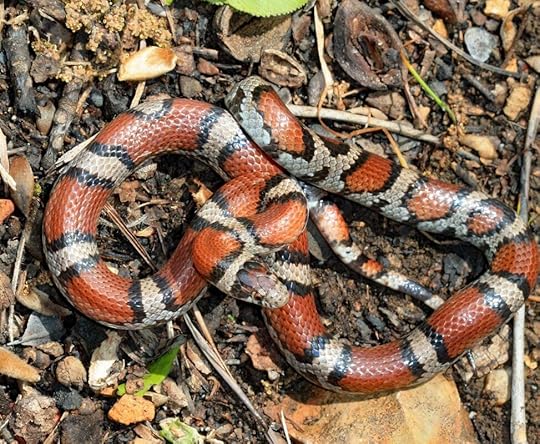

Photo Credits:
Milk snake and worm snake - Stan C. Smith
The second photo is a WESTERN WORM SNAKE. Few people ever see these snakes because they live in the soil and under rocks and logs. Their bright pink belly is a striking feature. These harmless little snakes have a hard, pointy tip at the end of their tail, and when attacked, they will poke the attacker with this tip, which sometimes startles the attacker, allowing the snake to escape. Because of this, some people claim this snake can sting. But this isn’t really a sting because the snake has no venom in its tail. In fact, the tail won’t even pierce skin. Another defense is, when picked up, they wriggle like crazy, making them hard to hold. A third defense is, like some other snakes, they secrete bad-smelling gunk when picked up. Trust me, it’s nasty stuff. Worm snakes love to eat earthworms, which they grab by one end and swallow alive.
Gotta love snakes, am I right?


Photo Credits:
Milk snake and worm snake - Stan C. Smith
Published on August 13, 2024 06:34
August 5, 2024
Life's Great Mysteries - If tickling makes us uncomfortable, why do we laugh?
Our normal response to another person tickling us is to pull away, to put an end to the discomfort. Because it really is discomfort, right? Almost like a type of pain. We squirm, we run away, we do whatever we can to put an end to it. Laughing seems like a weird response to such discomfort. We don’t laugh when we burn our finger on a hot pan, yet we pull away from a tickle as enthusiastically as we pull away from a hot pan. What’s up with the laughing? Why don’t we cry or shout instead?
I should point out that humans are not the only animals capable of laughing. Scientists have found that at least 65 other species laugh (hyenas are not one of them, by the way). And some of those also laugh when tickled.
Researchers recognize two types of tickling. Light tickling (knismesis), which is light touching with fingers or something like a feather. People can often respond to this in different ways, and they do not have to laugh. Heavy tickling (gargalesis) is intentionally touching sensitive areas like feet and armpits intending to get a reaction. When getting their feet tickled, most people have to laugh, even if they try not to. It’s involuntary. Other species of great apes also laugh when their feet get tickled.
When we get tickled, the nerve endings under the skin send signals to our brain. The anterior cingulated cortex analyzes the signals—this is the part of the brain that deals with the perception of pleasure. So, it’s important to know that your brain is interpreting the sensation as a type of pleasure (this helps explain why we respond with laughter instead of aggression).
But there’s more. The hypothalamus is the part of the brain that tells us to laugh when we are lightly tickled, but it is also the part of the brain that tells us we should expect pain when something is touching our most sensitive spots. The amalgamation of all these signals usually results in laughter.
That may explain how we end up laughing, but it doesn’t explain WHY. Evolutionary biologists and neuroscientists suggest that this response might have evolved as a defensive mechanism. Think of it this way… when a dog is intimidated by a larger dog or person, the dog will show submissive behavior, like rolling on its back to expose its vulnerable belly. This serves to signal that the dog is not being aggressive and is not looking for a fight, and therefore this behavior often prevents escalation. Well, the same idea could be true for laughing when being tickled. Laughing signals that we are not angry, that we are not the aggressor. Contributing to this is the fact that we know tickling is typically something people do out of fun, rather than as an attack, and therefore we do not need to do something more aggressive than laugh.
And this helps explain why we don’t laugh when we tickle ourselves. The cerebellum of your brain knows that you are about to self-tickle, and therefore it doesn’t bother wasting energy sending signals to the other parts of your brain that would trigger a laughing response. Your brain knows there is no need for a defensive response. It knows you do not need to signal another person to show that you are not angry.

Photo Credits:
- Tickling in bed - DepositPhotos
I should point out that humans are not the only animals capable of laughing. Scientists have found that at least 65 other species laugh (hyenas are not one of them, by the way). And some of those also laugh when tickled.
Researchers recognize two types of tickling. Light tickling (knismesis), which is light touching with fingers or something like a feather. People can often respond to this in different ways, and they do not have to laugh. Heavy tickling (gargalesis) is intentionally touching sensitive areas like feet and armpits intending to get a reaction. When getting their feet tickled, most people have to laugh, even if they try not to. It’s involuntary. Other species of great apes also laugh when their feet get tickled.
When we get tickled, the nerve endings under the skin send signals to our brain. The anterior cingulated cortex analyzes the signals—this is the part of the brain that deals with the perception of pleasure. So, it’s important to know that your brain is interpreting the sensation as a type of pleasure (this helps explain why we respond with laughter instead of aggression).
But there’s more. The hypothalamus is the part of the brain that tells us to laugh when we are lightly tickled, but it is also the part of the brain that tells us we should expect pain when something is touching our most sensitive spots. The amalgamation of all these signals usually results in laughter.
That may explain how we end up laughing, but it doesn’t explain WHY. Evolutionary biologists and neuroscientists suggest that this response might have evolved as a defensive mechanism. Think of it this way… when a dog is intimidated by a larger dog or person, the dog will show submissive behavior, like rolling on its back to expose its vulnerable belly. This serves to signal that the dog is not being aggressive and is not looking for a fight, and therefore this behavior often prevents escalation. Well, the same idea could be true for laughing when being tickled. Laughing signals that we are not angry, that we are not the aggressor. Contributing to this is the fact that we know tickling is typically something people do out of fun, rather than as an attack, and therefore we do not need to do something more aggressive than laugh.
And this helps explain why we don’t laugh when we tickle ourselves. The cerebellum of your brain knows that you are about to self-tickle, and therefore it doesn’t bother wasting energy sending signals to the other parts of your brain that would trigger a laughing response. Your brain knows there is no need for a defensive response. It knows you do not need to signal another person to show that you are not angry.

Photo Credits:
- Tickling in bed - DepositPhotos
Published on August 05, 2024 06:57
August 1, 2024
In our neck of the woods... Junk Bugs
Trish and I were sitting on our deck recently, and we noticed a little ball of fuzz that seemed to be walking across the glass tabletop. The fuzzball was less than a centimeter long. Fascinated by this strange sight, we looked closer and saw that it actually had legs, and a head with two large, wicked-looking mandibles. The first photo is the best one I could get with my phone. You can see legs and the mandibles.
We decided it had to be some kind of insect. Perplexed, we did some research. It turns out this is the larva of a green lacewing. These are often called debris-carrying lacewing larvae. AKA junk bug or trash bug. Yes, it's a real thing. These insect larvae disguise themselves by attaching junk to their backs. You can't make this stuff up.
The larvae of some green lacewings have numerous bristles on their backs, allowing them to pick up pieces of junk and attach them to their back, as camouflage. They attach plant fibers, lichens, miscellaneous debris, and their favorite—the dead bodies of their victims.
Green lacewing larvae (and adults) are predators, preying on aphids and other tiny soft-bodied insects. Hence the wicked-looking mandibles. They grab insects with those mandibles and suck the juices from their bodies. Then, instead of leaving the dry husks of their victims behind, the larvae plop them onto their back, adding new junk to their clever disguise.
The second photo is a debris-carrying lacewing larva sporting the remains of its many victims.
So, is there any proof that this trash-carrying habit actually helps hide the lacewing larvae? After all, maybe these little trash-mongers simply consider the heap on their back to be fashionable. Actually, there is proof. I'll explain a few details. You may know that ants are often the guardians of aphids. Ants and aphids have a fascinating symbiotic relationship, in which aphids provide ants with honeydew (a yummy food rich in sugar). The ants actually "milk" the aphids by stroking their backs, causing them to secrete honeydew, which the ants happily slurp. In return, the ants protect the aphids by attacking any aphid-loving predators (such as lacewing larvae) that come near the aphids.
Well, biologists, being forever curious, removed the trash from the backs of lacewing larvae. When these trash-free larva attempted to enter an aphid colony, the ants quickly identified them and attacked. However, when the lacewing larvae were allowed to keep their trash piles on their backs (consisting mainly of aphid carcasses), they easily snuck by the ants undetected and gorged themselves on tasty aphids.
So, if you ever see a tiny walking pile of junk, take a closer look, and compliment the lacewing larvae on its clever, stylish disguise.
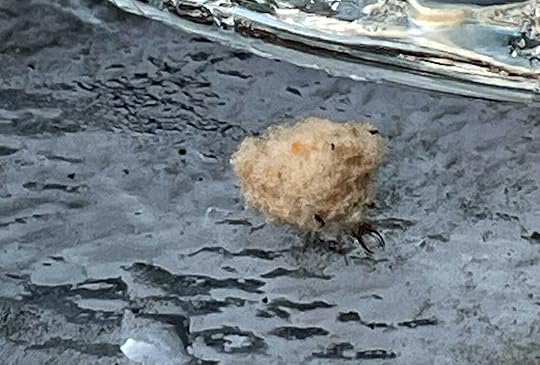
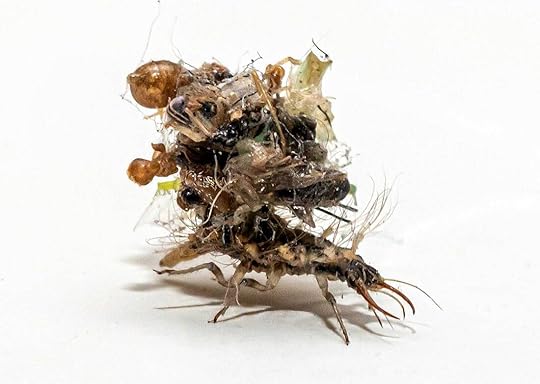
Photo Credits:
- Lacewing larva on glass table - Stan C. Smith
- Lacewing larva on white background - DepositPhotos
We decided it had to be some kind of insect. Perplexed, we did some research. It turns out this is the larva of a green lacewing. These are often called debris-carrying lacewing larvae. AKA junk bug or trash bug. Yes, it's a real thing. These insect larvae disguise themselves by attaching junk to their backs. You can't make this stuff up.
The larvae of some green lacewings have numerous bristles on their backs, allowing them to pick up pieces of junk and attach them to their back, as camouflage. They attach plant fibers, lichens, miscellaneous debris, and their favorite—the dead bodies of their victims.
Green lacewing larvae (and adults) are predators, preying on aphids and other tiny soft-bodied insects. Hence the wicked-looking mandibles. They grab insects with those mandibles and suck the juices from their bodies. Then, instead of leaving the dry husks of their victims behind, the larvae plop them onto their back, adding new junk to their clever disguise.
The second photo is a debris-carrying lacewing larva sporting the remains of its many victims.
So, is there any proof that this trash-carrying habit actually helps hide the lacewing larvae? After all, maybe these little trash-mongers simply consider the heap on their back to be fashionable. Actually, there is proof. I'll explain a few details. You may know that ants are often the guardians of aphids. Ants and aphids have a fascinating symbiotic relationship, in which aphids provide ants with honeydew (a yummy food rich in sugar). The ants actually "milk" the aphids by stroking their backs, causing them to secrete honeydew, which the ants happily slurp. In return, the ants protect the aphids by attacking any aphid-loving predators (such as lacewing larvae) that come near the aphids.
Well, biologists, being forever curious, removed the trash from the backs of lacewing larvae. When these trash-free larva attempted to enter an aphid colony, the ants quickly identified them and attacked. However, when the lacewing larvae were allowed to keep their trash piles on their backs (consisting mainly of aphid carcasses), they easily snuck by the ants undetected and gorged themselves on tasty aphids.
So, if you ever see a tiny walking pile of junk, take a closer look, and compliment the lacewing larvae on its clever, stylish disguise.


Photo Credits:
- Lacewing larva on glass table - Stan C. Smith
- Lacewing larva on white background - DepositPhotos
Published on August 01, 2024 06:12
In our neck of the woods... A few herps
A few cool critters I've found near the house recently. The first photo is one of the prettiest GRAY TREEFROGS I've seen. As you might guess, gray treefrogs are usually gray in color, Their mottled pattern makes them look like lichens on a tree. However, especially around their breeding season, many of them turn green, like this one. Gray treefrogs typically eat insects, but when they get larger, they will feed on anything that moves, including smaller frogs. Around our house, whenever it rains, the gray treefrogs start singing (singing in the rain!).
The second photo is a FIVE-LINED SKINK I found hiding under a rock. Five-lined skinks are common in Missouri, though they are secretive. If you are walking in the woods and hear something scuttling away in dry leaves, it's probably a five-lined skink. The juveniles of this lizard species have bright blue tails, so some people call them blue-tailed skinks. But this name is confusing because many types of skinks have blue tails as juveniles. When a predator attacks a juvenile skink, the skink's tail will break off and wriggle around—the bright blue wriggling thing distracts the predator, allowing the young skink to escape.
The third photo is a RED-BELLIED SNAKE. It's probably obvious how it got its name. These harmless little snakes like to snarf up slugs, snails, and earthworms. They have a special adaptation for eating slimy snails—extra-long teeth. These teeth allow the snake to grab a snail's soft body and pull. The snail eventually grows tired of the fight, and the snake actually pulls the snail's soft body out of its shell to consume it. These snakes also have an odd habit of flaring their lips out, which is probably a behavior that exposes their teeth to better hold on to their slimy prey.
Isn't it awesome that so many amazing little critters are hanging around underfoot and in the trees above?
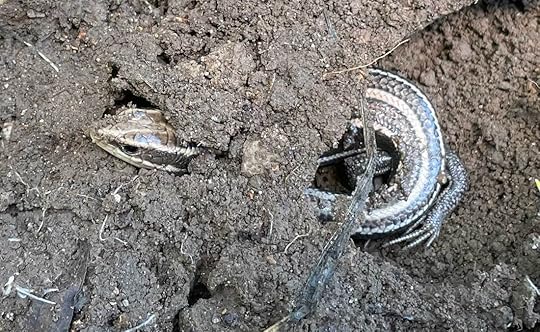
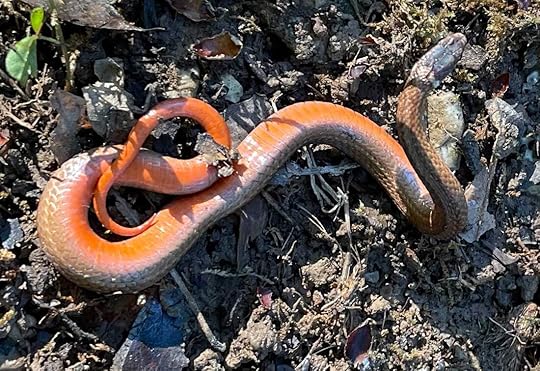
Photo Credits:
All photos by Stan C. Smith
The second photo is a FIVE-LINED SKINK I found hiding under a rock. Five-lined skinks are common in Missouri, though they are secretive. If you are walking in the woods and hear something scuttling away in dry leaves, it's probably a five-lined skink. The juveniles of this lizard species have bright blue tails, so some people call them blue-tailed skinks. But this name is confusing because many types of skinks have blue tails as juveniles. When a predator attacks a juvenile skink, the skink's tail will break off and wriggle around—the bright blue wriggling thing distracts the predator, allowing the young skink to escape.
The third photo is a RED-BELLIED SNAKE. It's probably obvious how it got its name. These harmless little snakes like to snarf up slugs, snails, and earthworms. They have a special adaptation for eating slimy snails—extra-long teeth. These teeth allow the snake to grab a snail's soft body and pull. The snail eventually grows tired of the fight, and the snake actually pulls the snail's soft body out of its shell to consume it. These snakes also have an odd habit of flaring their lips out, which is probably a behavior that exposes their teeth to better hold on to their slimy prey.
Isn't it awesome that so many amazing little critters are hanging around underfoot and in the trees above?



Photo Credits:
All photos by Stan C. Smith
Published on August 01, 2024 06:08
July 24, 2024
Awesome Animal Fact: Hourglass Dolphin
Did you know there is a small but beautiful dolphin species that inhabit only the waters near Antarctica? Hourglass dolphins average only about five feet (1.6 m) long, with a stubby beak (snout). They have a striking black and white pattern, with the white on each side of the body resembling a horizontal hourglass.
These are the only small dolphins that live in the waters of Antarctica. Like other cetaceans (whales and dolphins), hourglass dolphins swim in pods, sometimes with up to a hundred individuals, though they are usually seen in smaller pods of eight to twelve. They seem to enjoy riding the waves of fast-moving ships. They also feed at the surface (on fish and squid). These surface habits make it easier for scientists to locate hourglass dolphins to monitor their numbers. However, the last sighting survey was done in 1987-1988, almost forty years ago. At that time, scientists estimated the population to be about 144,000.
The numbers have probably declined slightly since then, but these dolphins are relatively safe simply because few humans travel to Antarctica. If you haven't guessed, human presence is usually bad for whales and dolphins. Unfortunately, in the coming years, climate change may threaten these dolphins.
Because of the distinct black and white pattern, whalers originally referred to hourglass dolphins as "sea cows" or "sea skunks."

Photo Credits:
- Hourglass dolphins - Lomvi2, CC BY-SA 3.0, via Wikimedia Commons
These are the only small dolphins that live in the waters of Antarctica. Like other cetaceans (whales and dolphins), hourglass dolphins swim in pods, sometimes with up to a hundred individuals, though they are usually seen in smaller pods of eight to twelve. They seem to enjoy riding the waves of fast-moving ships. They also feed at the surface (on fish and squid). These surface habits make it easier for scientists to locate hourglass dolphins to monitor their numbers. However, the last sighting survey was done in 1987-1988, almost forty years ago. At that time, scientists estimated the population to be about 144,000.
The numbers have probably declined slightly since then, but these dolphins are relatively safe simply because few humans travel to Antarctica. If you haven't guessed, human presence is usually bad for whales and dolphins. Unfortunately, in the coming years, climate change may threaten these dolphins.
Because of the distinct black and white pattern, whalers originally referred to hourglass dolphins as "sea cows" or "sea skunks."

Photo Credits:
- Hourglass dolphins - Lomvi2, CC BY-SA 3.0, via Wikimedia Commons
Published on July 24, 2024 08:47
July 15, 2024
Life's Great Mysteries - Why do we look up when thinking hard about something?
I do it all the time, and I’ve seen other people do it. We are trying to remember something, or trying to come up with a creative idea, or trying to think of what to say, so we tilt our head back and look up. Or we at least direct our eyes upward. Do we expect the answer to be written on the ceiling? Do we think the heavens might help us remember that forgotten name of an old acquaintance? Are we begging the universe for help?
Here's one explanation. Most of us think better when we have fewer distractions. If you stare at something complex, like a page in a dictionary, it's hard to rid your mind of all those visual distractions. If you stare at a blank wall, you have fewer distractions. Now, if you consider that humans lived outdoors throughout most of our history, what would our ancestors usually see when they looked up? The sky. And the sky has few distractions, even when there are clouds. You would certainly see fewer distractions than when looking down at the ground. By eliminating those distractions, we are transferring all our mental faculties from external to internal stimuli. We can think better.
Here's another aspect of this to consider. Psychologists have long believed that thinking involves the same brain structures that evolved from pre-existing neural connections for searching for things visually. When you search for a person in a crowd, or search around the house for something you’ve lost, you naturally move your eyes around to help you. This ancient behavior may have also contributed to why we tend to look up when we are thinking. We naturally want to move our eyes, and the best place to look is where there are fewer distractions… the sky.

Photo Credits:
- Thinking woman - DepositPhotos
Here's one explanation. Most of us think better when we have fewer distractions. If you stare at something complex, like a page in a dictionary, it's hard to rid your mind of all those visual distractions. If you stare at a blank wall, you have fewer distractions. Now, if you consider that humans lived outdoors throughout most of our history, what would our ancestors usually see when they looked up? The sky. And the sky has few distractions, even when there are clouds. You would certainly see fewer distractions than when looking down at the ground. By eliminating those distractions, we are transferring all our mental faculties from external to internal stimuli. We can think better.
Here's another aspect of this to consider. Psychologists have long believed that thinking involves the same brain structures that evolved from pre-existing neural connections for searching for things visually. When you search for a person in a crowd, or search around the house for something you’ve lost, you naturally move your eyes around to help you. This ancient behavior may have also contributed to why we tend to look up when we are thinking. We naturally want to move our eyes, and the best place to look is where there are fewer distractions… the sky.

Photo Credits:
- Thinking woman - DepositPhotos
Published on July 15, 2024 14:18
July 9, 2024
In our neck of the woods... summer youngsters
Mallard Ducklings - Most mallards migrate to the northern US and Canada to breed, but some skip the whole exhausting migration ordeal and decide to breed right here in Missouri.
Mallards are the most abundant species of duck in North America. Hen mallards make their nests on the ground (usually near water, but sometimes as far as a mile from water), and lay an average of 7 to 10 eggs. Although the hen and drake stay together before the eggs are laid, the drake usually leaves the hen once she lays the eggs.
The hen incubates the eggs for about 28 days before they hatch. The ducklings can walk, feed, and swim as soon as they hatch. After all the eggs hatch, the hen leads the young to water (yep, even walking a mile if necessary), and they never return to the nest. The ducklings stay close to the hen for about two months, until they can fly.
By the way, mallards are the ducks that make the classic quack sound. Most other ducks make sounds that are decidedly unquacky (my new made-up word for the day).

Photo Credit:
Mallards - Stan C. Smith
Mallards are the most abundant species of duck in North America. Hen mallards make their nests on the ground (usually near water, but sometimes as far as a mile from water), and lay an average of 7 to 10 eggs. Although the hen and drake stay together before the eggs are laid, the drake usually leaves the hen once she lays the eggs.
The hen incubates the eggs for about 28 days before they hatch. The ducklings can walk, feed, and swim as soon as they hatch. After all the eggs hatch, the hen leads the young to water (yep, even walking a mile if necessary), and they never return to the nest. The ducklings stay close to the hen for about two months, until they can fly.
By the way, mallards are the ducks that make the classic quack sound. Most other ducks make sounds that are decidedly unquacky (my new made-up word for the day).

Photo Credit:
Mallards - Stan C. Smith
Published on July 09, 2024 06:48
July 5, 2024
In our neck of the woods... summer youngsters
Missouri is home to the eastern subspecies of the wild turkey (there are a total of five wild turkey subspecies in North America). A few days ago, I looked out the door and saw two hens with twelve poults (young turkeys). They were a good distance away, and the photo only shows three of the poults and the hens. These poults are already about the size of chickens.
During the winter, turkeys gather together and roam around through the forest in flocks, searching for acorns and other seeds. Being in large flocks makes it easier to find food and avoid predators. In the spring, the flocks break up, and the toms start gobbling to attract hens to mate with. The hens then create nests on the ground and lay about 10 to 14 eggs (usually laying one egg per day). The eggs hatch after the hen incubates them for about 28 days. After hatching, the poults can walk within hours. They can fly after about two weeks. So, the poults in this photo are almost certainly able to fly.
The poults are very vulnerable to predators during the two weeks before they can fly. Once they can fly, they begin roosting in trees, like the adults do. Interestingly, if a predator finds a turkey nest and destroys the eggs, this often triggers the hen to start laying eggs again.
Before modern conservation efforts began, wild turkeys almost went extinct in North America. In the 1800s, the entire population dropped to only about 30,000. Today, there are about seven million.
The second photo is a mature tom that likes to visit our yard.
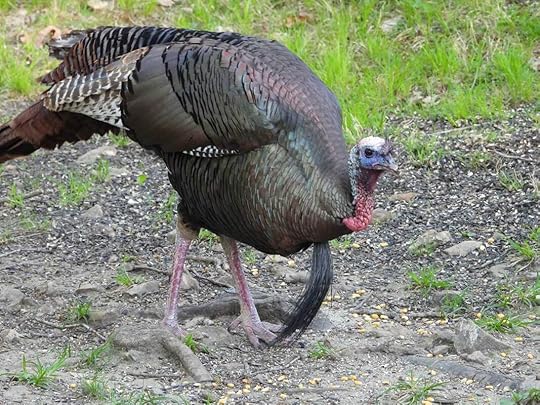
Photo credits:
Eastern turkeys - Stan C. Smith
During the winter, turkeys gather together and roam around through the forest in flocks, searching for acorns and other seeds. Being in large flocks makes it easier to find food and avoid predators. In the spring, the flocks break up, and the toms start gobbling to attract hens to mate with. The hens then create nests on the ground and lay about 10 to 14 eggs (usually laying one egg per day). The eggs hatch after the hen incubates them for about 28 days. After hatching, the poults can walk within hours. They can fly after about two weeks. So, the poults in this photo are almost certainly able to fly.
The poults are very vulnerable to predators during the two weeks before they can fly. Once they can fly, they begin roosting in trees, like the adults do. Interestingly, if a predator finds a turkey nest and destroys the eggs, this often triggers the hen to start laying eggs again.
Before modern conservation efforts began, wild turkeys almost went extinct in North America. In the 1800s, the entire population dropped to only about 30,000. Today, there are about seven million.
The second photo is a mature tom that likes to visit our yard.


Photo credits:
Eastern turkeys - Stan C. Smith
Published on July 05, 2024 08:37
July 2, 2024
In our neck of the woods... summer youngsters
This white-tailed deer fawn wandered into the fenced-in area of our yard with its mother, then it bedded down to wait for its mother to go in search of food.
White-tailed deer fawns have spots to help camouflage them while they are bedded down like this. Unfortunately, people often find them alone and assume they've been abandoned by the mother. Then the people try to "rescue" the fawn, which can result in the fawn's death.
During the first few months of a fawn's life, it spends most of its time away from the mother (the doe). This is for a good reason. Fawns can walk and run soon after birth, but they are not fast enough to escape predators that are attracted to the mother (the mother is larger and more active, therefore is more visible to predators). Fawns are much safer bedded down on their own than they are when they try to follow the mother around. They lie very still and only get up and run if a predator comes extremely close. When the fawn senses danger, it will often lay its head low, flatten its ears, and stop breathing, all to reduce its visibility.
Remember, the fawn is safer on its own, so the mother visits the fawn only a few times per day, and very briefly. During these visits, the mother allows the fawn to nurse and moves the fawn to a new location. If humans, pets, or predators are around, the mother stays away from the fawn until the danger passes.
Does often have twins, or even triplets. When this happens, the doe separates the young. This way, if a predator finds one fawn, it probably won't find the other(s).
If a predator flushes a fawn, forcing it to flee, the mother can still find it because the fawn will make bleating sounds once it's safe and is ready to find its mother.
So, if you find a fawn bedded down like this, don't assume it is abandoned. The best thing to do is leave it alone.

Photo Credit:
White-tailed deer fawn - Stan C. Smith
White-tailed deer fawns have spots to help camouflage them while they are bedded down like this. Unfortunately, people often find them alone and assume they've been abandoned by the mother. Then the people try to "rescue" the fawn, which can result in the fawn's death.
During the first few months of a fawn's life, it spends most of its time away from the mother (the doe). This is for a good reason. Fawns can walk and run soon after birth, but they are not fast enough to escape predators that are attracted to the mother (the mother is larger and more active, therefore is more visible to predators). Fawns are much safer bedded down on their own than they are when they try to follow the mother around. They lie very still and only get up and run if a predator comes extremely close. When the fawn senses danger, it will often lay its head low, flatten its ears, and stop breathing, all to reduce its visibility.
Remember, the fawn is safer on its own, so the mother visits the fawn only a few times per day, and very briefly. During these visits, the mother allows the fawn to nurse and moves the fawn to a new location. If humans, pets, or predators are around, the mother stays away from the fawn until the danger passes.
Does often have twins, or even triplets. When this happens, the doe separates the young. This way, if a predator finds one fawn, it probably won't find the other(s).
If a predator flushes a fawn, forcing it to flee, the mother can still find it because the fawn will make bleating sounds once it's safe and is ready to find its mother.
So, if you find a fawn bedded down like this, don't assume it is abandoned. The best thing to do is leave it alone.

Photo Credit:
White-tailed deer fawn - Stan C. Smith
Published on July 02, 2024 10:28



